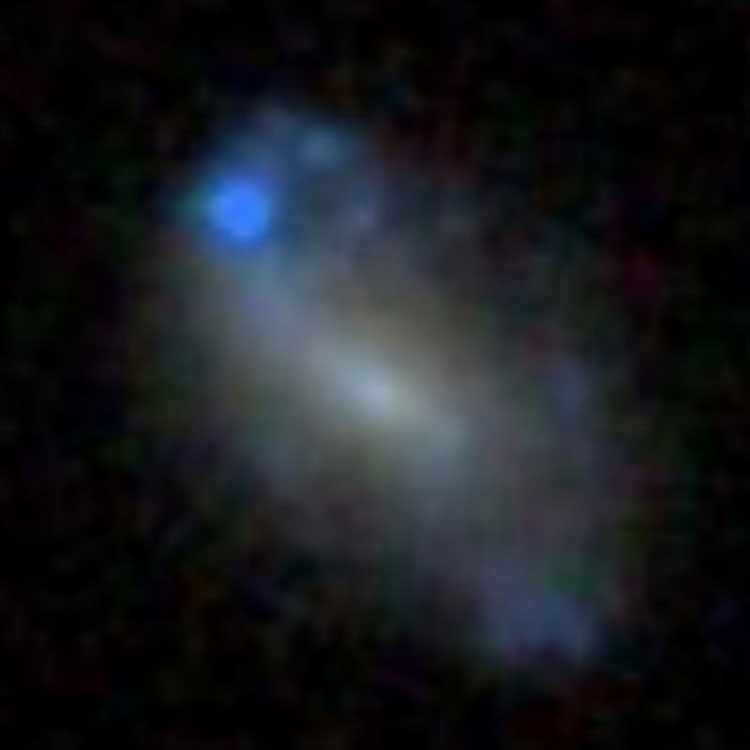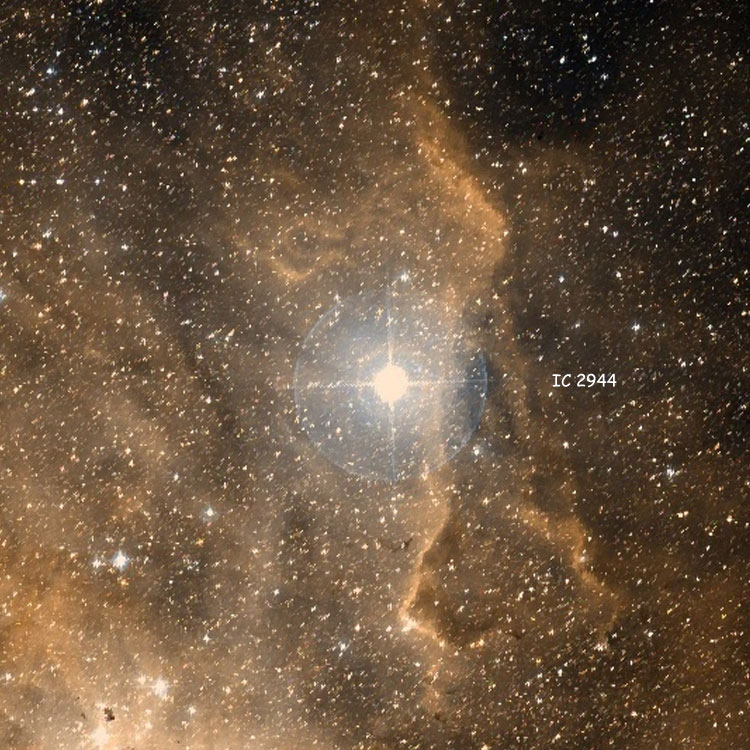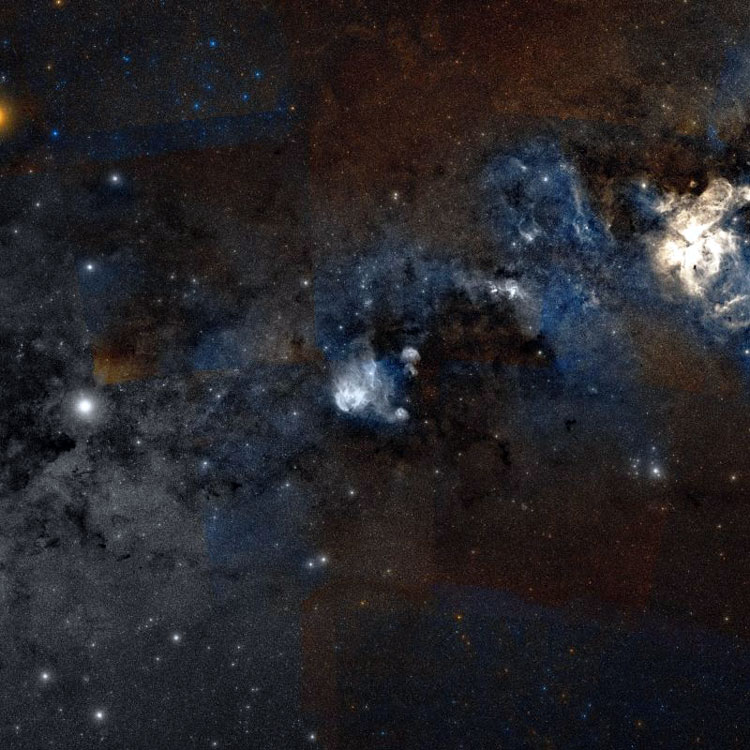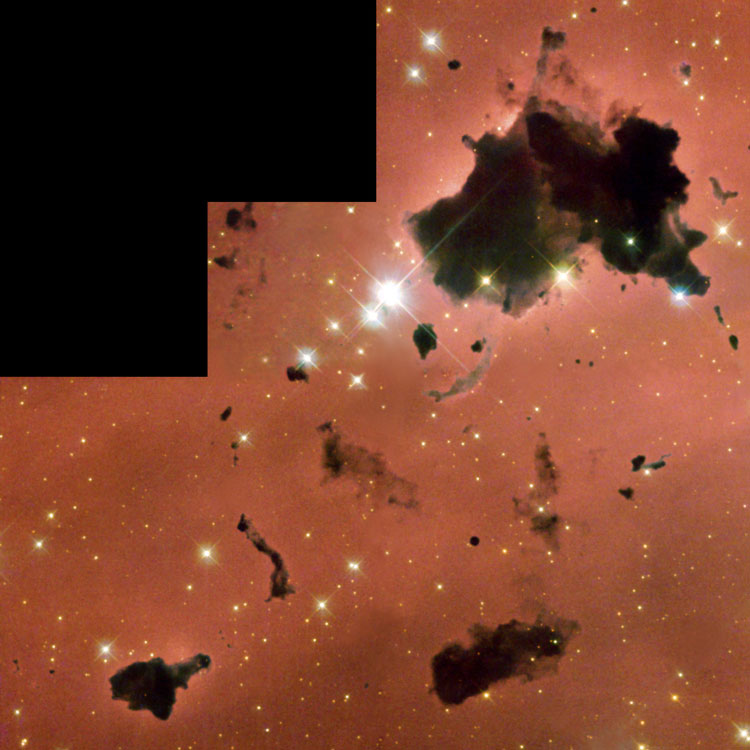QuickLinks:
2900, 2901, 2902, 2903, 2904, 2905, 2906, 2907, 2908, 2909, 2910, 2911, 2912, 2913, 2914, 2915, 2916,
2917, 2918, 2919, 2920, 2921, 2922, 2923, 2924, 2925, 2926, 2927, 2928, 2929, 2930, 2931, 2932, 2933,
2934, 2935, 2936, 2937, 2938, 2939, 2940, 2941, 2942, 2943, 2944, 2945, 2946, 2947, 2948, 2949
Page last updated Sep 24, 2023 (Added Caldwell & other IDs (and an image?) for IC 2944)
Page last updated Oct 26, 2013
WORKING: Check positions, historical IDs (Corwin+), add basic pix, captions, tags
IC 2900 (= PGC 1424467)
Discovered (Mar 27, 1906) by Max Wolf (7-272)
A magnitude 16.9 spiral galaxy (type SBb?) in Leo (RA 11 31 29.6, Dec +13 10 04)
Based on a recessional velocity of 25190 km/sec, a straightforward calculation indicates that IC 2900 is about 1.15 billion light years away. However, for objects at that distance we need to take the expansion of the Universe during their light-travel time into account. Doing that shows that the galaxy was about 1.05 billion light years away at the time the light by which we see it was emitted, about 1.1 billion years ago (the difference between the two numbers being due to the expansion of the Universe during that interval). Given that and its apparent size of 0.3 by 0.25 arcmins, the galaxy is about 90 thousand light years across.

Above, a 0.6 arcmin wide SDSS image of IC 2900
Below, a 12 arcmin wide SDSS image centered on the galaxy

IC 2901 (= PGC 1414499)
Discovered (Mar 27, 1906) by Max Wolf (7-273)
A magnitude 17.1 spiral galaxy (type S??) in Leo (RA 11 31 32.1, Dec +12 42 01)
Apparent size 0.4 by 0.3 arcmin?
IC 2902
Recorded (Mar 27, 1906) by Max Wolf (7-274)
A magnitude 14(?) star in Leo (RA 11 31 33.2, Dec +14 13 21)
IC 2903 (= PGC 1413381)
Discovered (Mar 27, 1906) by Max Wolf (7-275)
A magnitude 15.2 spiral galaxy (type S??) in Leo (RA 11 31 40.8, Dec +12 38 32)
Apparent size 0.4 by 0.2 arcmin?
IC 2904
Recorded (Mar 27, 1906) by Max Wolf (7-276)
A star in Leo (RA 11 31 42.5, Dec +13 11 05)
IC 2905
Recorded (Mar 27, 1906) by Max Wolf (7-277)
A star in Leo (RA 11 31 47.1, Dec +09 06 25)
IC 2906
Recorded (Mar 27, 1906) by Max Wolf (7-278)
A magnitude 15(?) star in Leo (RA 11 31 49.6, Dec +13 07 58)
IC 2907
Recorded (Mar 27, 1906) by Max Wolf (7-279)
A magnitude 15(?) star in Leo (RA 11 31 49.0, Dec +09 53 57)
IC 2908
Recorded (Mar 27, 1906) by Max Wolf (7-280)
A star in Leo (RA 11 31 50.6, Dec +12 56 17)
IC 2909 (= PGC 1394107)
Discovered (Mar 27, 1906) by Max Wolf (7-281)
A magnitude 16.0 elliptical galaxy (type E0??) in Leo (RA 11 31 50.9, Dec +11 28 13)
Apparent size 0.2 by 0.2 arcmin?
IC 2910 (= PGC 35557)
Discovered (Mar 29, 1895) by Guillaume Bigourdan (282)
A magnitude 13.6 lenticular galaxy (type S0/a??) in Crater (RA 11 31 54.6, Dec -09 43 29)
Apparent size 1.7 by 1.2 arcmin?
IC 2911
Recorded (Mar 27, 1906) by Max Wolf (7-282)
A pair of stars in Leo (RA 11 32 05.3, Dec +12 58 41)
IC 2912 (= PGC 1397617)
Discovered (Mar 27, 1906) by Max Wolf (7-283)
A magnitude 15.2 spiral galaxy (type S??) in Leo (RA 11 32 07.0, Dec +11 42 37)
Apparent size 0.5 by 0.1 arcmin?
IC 2913 (= PGC 35554)
Discovered (Feb 12, 1898) by Lewis Swift (XI-122)
A magnitude 13.0 lenticular galaxy (type S0/a??) in Hydra (RA 11 31 51.3, Dec -30 24 38)
Apparent size 0.8 by 0.8 arcmin?
IC 2914 (= PGC 35580)
Discovered (Mar 27, 1906) by Max Wolf (7-284)
A magnitude 14.6 spiral galaxy (type S??) in Leo (RA 11 32 12.4, Dec +13 29 31)
Apparent size 0.6 by 0.3 arcmin?
IC 2915
Recorded (Mar 27, 1906) by Max Wolf (7-285)
A magnitude 14(?) star in Leo (RA 11 32 15.6, Dec +14 29 02)
IC 2916
Recorded (Mar 27, 1906) by Max Wolf (7-286)
A star in Leo (RA 11 32 16.1, Dec +11 41 02)
IC 2917 (= PGC 1386736)
Discovered (Mar 27, 1906) by Max Wolf (7-287)
A magnitude 16.7 spiral galaxy (type S??) in Leo (RA 11 32 19.4, Dec +10 56 45)
Apparent size 0.15 by 0.1 arcmin?
IC 2918
Recorded (Mar 27, 1906) by Max Wolf (7-288)
A lost or nonexistent object in Leo (RA 11 32 26.2, Dec +13 14 55)
IC 2919 (= PGC 35614)
Discovered (Mar 27, 1906) by Max Wolf (7-289)
A magnitude 16(?) spiral galaxy (type SBd? pec) in Leo (RA 11 32 35.0, Dec +14 11 25)
Apparent size about 0.5 by 0.35 arcmin. The bluish area on the northeastern edge is listed as a separate galaxy, PGC 4125925, but appears more likely to be a star-forming region, or perhaps a foreground star.

Above, a 0.6 arcmin wide SDSS image of IC 2919
Below, a 12 arcmin wide SDSS image centered on the galaxy

IC 2920
Recorded (Mar 27, 1906) by Max Wolf (7-290)
A magnitude 14(?) star in Leo (RA 11 32 49.0, Dec +12 33 26)
IC 2921 (= PGC 3091281)
Discovered (Mar 27, 1906) by Max Wolf (7-291)
A magnitude 16.0 spiral galaxy (type S??) in Leo (RA 11 32 49.2, Dec +10 17 49)
Apparent size 0.5 by 0.3 arcmin?
IC 2922
Recorded (Mar 27, 1906) by Max Wolf (7-292)
A star in Leo (RA 11 32 51.3, Dec +12 55 21)
IC 2923 (= PGC 1424388)
Discovered (Mar 27, 1906) by Max Wolf (7-293)
A magnitude 15.5 elliptical galaxy (type E0??) in Leo (RA 11 32 53.7, Dec +13 09 50)
Apparent size 0.2 by 0.2 arcmin?
IC 2924
Recorded (Mar 27, 1906) by Max Wolf (7-294)
A star in Leo (RA 11 32 52.3, Dec +09 01 26)
IC 2925 (= PGC 35667)
Discovered (May 29, 1903) by Stephane Javelle (1182)
A magnitude 14.9 spiral galaxy (type S??) in Ursa Major (RA 11 33 13.2, Dec +34 15 56)
Apparent size 0.5 by 0.2 arcmin?
IC 2926
Recorded (Mar 27, 1906) by Max Wolf (7-295)
A star in Leo (RA 11 33 04.7, Dec +12 26 13)
IC 2927
Recorded (Mar 27, 1906) by Max Wolf (7-296)
A star in Leo (RA 11 33 04.9, Dec +13 05 07)
IC 2928 (= PGC 35687)
Discovered (May 29, 1903) by Stephane Javelle (1183)
A magnitude 13.7 spiral galaxy (type Sbc?) in Ursa Major (RA 11 33 29.9, Dec +34 18 58)
Apparent size 1.0 by 0.8 arcmin.

Above, a 1.2 arcmin wide SDSS image of IC 2928
Below, a 12 arcmin wide SDSS image centered on the galaxy, also showing IC 2925

IC 2929 (= PGC 1404385)
Discovered (Mar 27, 1906) by Max Wolf (7-297)
A magnitude 15.9 spiral galaxy (type Sc?) in Leo (RA 11 33 31.4, Dec +12 08 12)
Apparent size 0.5 by 0.45 arcmin.

Above, a 0.8 arcmin wide SDSS image of IC 2929
Below, a 12 arcmin wide SDSS image centered on the galaxy

IC 2930 (= PGC 35700)
Discovered (Mar 27, 1906) by Max Wolf (7-298)
A magnitude 14.9 spiral galaxy (type S??) in Leo (RA 11 33 44.1, Dec +10 05 19)
Apparent size 0.5 by 0.2 arcmin?
IC 2931
Recorded (Mar 27, 1906) by Max Wolf (7-299)
A star in Leo (RA 11 33 50.6, Dec +12 28 00)
IC 2932
Recorded (Mar 27, 1906) by Max Wolf (7-300)
A pair of stars in Leo (RA 11 33 53.5, Dec +10 32 38)
IC 2933 (= PGC 35732)
Discovered (May 29, 1903) by Stephane Javelle (1184)
A magnitude 14.3 spiral galaxy (type SBab??) in Leo (RA 11 34 12.7, Dec +34 18 46)
Apparent size 1.3 by 0.4 arcmin?
IC 2934 (= PGC 35739)
Discovered (Mar 27, 1906) by Max Wolf (7-302)
A magnitude 15.3 spiral galaxy (type Scd?) in Leo (RA 11 34 19.6, Dec +13 19 17)
Apparent size 0.5 by 0.3 arcmin?
IC 2935
Recorded (Mar 27, 1906) by Max Wolf (7-303)
A lost or nonexistent object in Leo (RA 11 34 48.6, Dec +10 15 00)
IC 2936 (= PGC 1420782)
Discovered (Mar 27, 1906) by Max Wolf (7-304)
A magnitude 14.5 spiral galaxy (type Sc?) in Leo (RA 11 34 56.9, Dec +13 00 31)
Apparent size 0.2 by 0.2 arcmin?
IC 2937
Recorded (Mar 27, 1906) by Max Wolf (7-305)
A star in Leo (RA 11 35 03.4, Dec +10 06 14)
IC 2938 (= PGC 35837)
Discovered (Mar 27, 1906) by Max Wolf (7-306)
A magnitude 14.2 lenticular galaxy (type S0/a?) in Leo (RA 11 35 36.3, Dec +13 40 48)
Apparent size 0.6 by 0.6 arcmin? The brightest member of a group of several galaxies.
IC 2939
Recorded (Mar 27, 1906) by Max Wolf (7-307)
A magnitude 15(?) star in Leo (RA 11 35 38.0, Dec +10 41 50)
IC 2940
Recorded (Apr 29, 1891) by Guillaume Bigourdan (283)
A lost or nonexistent object in Leo (RA 11 36 02.7, Dec +21 57 42)
(Sometimes suggested as being NGC 3743, but since that was separately observed by Bigourdan, that cannot be right.)
IC 2941 (= PGC 35881)
Discovered (Mar 27, 1906) by Max Wolf (7-308)
A magnitude 13.7 spiral galaxy (type SB(r)ab?) in Leo (RA 11 36 10.0, Dec +10 03 21)
Apparent size 0.9 by 0.8 arcmin.

Above, a 1.2 arcmin wide SDSS image of IC 2941
Below, a 12 arcmin wide SDSS image centered on the galaxy

IC 2942 (= PGC 1399175)
Discovered (Mar 27, 1906) by Max Wolf (7-309)
A magnitude 15.4 spiral galaxy (type Sc?) in Leo (RA 11 36 12.0, Dec +11 48 55)
Apparent size 0.4 by 0.2 arcmin?
IC 2943 (= PGC 35926)
Discovered (Jul 6, 1896) by Hermann Kobold (4, K3)
A magnitude 14.3 spiral galaxy (type Sa??) in Ursa Major (RA 11 36 42.2, Dec +54 50 45)
Apparent size 0.4 by 0.4 arcmin?
IC 2944, the Lambda (λ) Centauri Nebula
(occasionally erroneously called the Running Chicken Nebula)
(= OCL 862 = C100 = ESO 094-SC004 = "PGC 3518696")
Discovered (May 5, 1904) by Royal Frost
A magnitude 4.2 emission nebula in Centaurus (RA 11 35 46.9, Dec -63 01 11)
Historical Identification: Per Dreyer, IC 2944 (Frost #789, 1860 RA 11 29 20, NPD 152 14.7) is "a 3.4 magnitude star in an extremely large nebula.". The position precesses to RA 11 35 47.1, Dec -63 01 09, essentially dead center on λ Centauri (its namesake), the description fits and there is nothing comparable nearby, so the identification is certain.
Discovery Notes: Per Gottlieb, Frost noted the nebula surrounding λ Centauri on a plate taken on May 5, 1904, but did not notice the open cluster contained within the nebula's boundaries; so although OCL 862 is part of IC 2944 (as shown in the boldface title of this entry), strictly speaking, only the nebula is the IC object. However, the NED listing for IC 2944 only refers to the star cluster, hence my inclusion of its OCL and ESO designations. Gottlieb also suggests reading Corwin's notes, but because of time constraints, anything there will be added as I finish more detailed discusssions of ALL the Caldwell Catalogue objects.
PGC Designation Note: As usual for IC objects, HyperLEDA assigned a PGC designation to this object, even though it isn't a galaxy; but also as usual under such circumstances a search of the database for that designation returns no result, hence its being in quotes.
AladinLite Warning: A search of that database for IC 2944 shows IC 2948, instead of IC 2944; only using the coordinates of IC 2944 results in the correct position.
Physical Information: About 40 by 20 arcmin apparent size, with magnitude 3.1 λ Centauri generally considered its center. Sometimes listed as the Running Chicken Nebula, but that name is also assigned to the much larger IC 2948, and there is no obvious reason for either nebula to be associated with a fowl of any sort, so which if either deserves the apparently useless appellation is unclear.
Image Notes Better versions of the 2nd & 3rd images to be posted later. Also, Thackeray's Globules, often stated as being in IC 2944, appear to actually be in IC 2948, so for now see that entry for images of them.

Above, a 45 arcmin wide DSS image centered on IC 2944
Below, a 2 degree wide DSS image centered on the nebula and λ Centauri, also showing IC 2872 and 2948

Below, a 15 degree wide DSS image centered near IC 2944, also showing η Carinae

IC 2945 (= PGC 35958)
Discovered (Mar 27, 1906) by Max Wolf (7-310)
A magnitude 13.8 lenticular galaxy (type S0/a?) in Leo (RA 11 37 04.2, Dec +12 55 37)
Apparent size 1.0 by 0.8 arcmin?
IC 2946 (= PGC 35984)
Discovered (Jun 13, 1896) by Stephane Javelle (1185)
A magnitude 14.1 spiral galaxy (type SBa??) in Ursa Major (RA 11 37 29.6, Dec +32 15 11)
Apparent size 0.5 by 0.3 arcmin?
IC 2947 (= PGC 35981)
Discovered (Jun 13, 1896) by Stephane Javelle (1186)
A magnitude 14.0 spiral galaxy (type SBm??) in Ursa Major (RA 11 37 31.1, Dec +31 21 42)
Apparent size 0.7 by 0.6 arcmin?
IC 2948
Discovered (May 5, 1904) by Royal Frost (790)
Some references list IC 2948 as the Running Chicken Nebula, but other sources assign that name to IC 2944, and there is no obvious reason for either nebula to be associated with a fowl of any sort, so which if either deserves the apparently useless appellation is unclear. Dark globules near the center of IC 2948 are examples of "Bok globules", but are called Thackeray's Globules, after their discoverer in this particular nebula. There appears to be some confusion about which part of this and its companion (IC 2944) is which. The HST image below is labeled as being in IC 2944 in every reference I've seen, but the region is actually near the center of IC 2948. This confusion will hopefully be resolved when I post the history of the IC listing in the next iteration of this page. Apparent size 45 by 40 arcmin?

Above, a 1 degree wide DSS image centered on IC 2948; Thackeray's Globules are above right center
Below, a HST image of Thackeray's Globules (Credits: NASA/ESA and The Hubble Heritage Team STScI/AURA)

Below, a 2 degree wide DSS image centered near IC 2944 and λ Centauri, also showing IC 2872 and 2948

Below, a 15 degree wide DSS image centered near IC 2944, also showing η Carinae

IC 2949
Recorded (Jul 27, 1884) by William Finlay (3)
A pair of stars in Centaurus (RA 11 40 54.4, Dec -46 27 16)
|